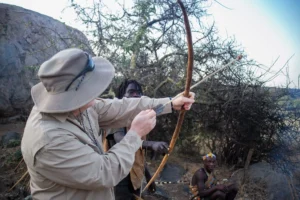Hadzabe Tribe

The Hadzabe, also known as the Hadzabe or the Hadzabe people, are an indigenous ethnic group found in northern Tanzania, primarily in the areas surrounding Lake Eyasi, the Ngorongoro Highlands, and the southern Serengeti. They are one of the last remaining hunter-gatherer tribes in East Africa, preserving a traditional way of life that has remained largely unchanged for thousands of years.
Key Aspects of the Hadzabe Tribe:
Lifestyle:
- The Hadzabe are semi-nomadic and rely on hunting and foraging for survival. They hunt game such as antelope, baboons, and birds, and gather wild fruits, honey, tubers, and berries.
- Their hunting methods are sophisticated, using bows and arrows crafted from locally sourced materials. They are known for their deep knowledge of the land and natural resources, and their skills are passed down through generations.
- The tribe is largely self-sufficient, with little reliance on external trade or agriculture. Their social organization is egalitarian, with no strict hierarchy or central authority.
Language:
- The Hadzabe speak a language known as Hadza, which belongs to the Khoisan language family. The language is characterized by click sounds and has no known relation to other languages in the region.
Cultural Practices:
- The Hadzabe have a rich oral tradition, with stories, songs, and myths that are integral to their cultural identity. They do not have a written language but pass down knowledge through spoken word and rituals.
- Spiritual beliefs revolve around nature, with a deep respect for the animals and land that sustain them. They believe in a spiritual connection to the earth and its creatures, and this belief influences their hunting practices and respect for the environment.
- Traditional dress is minimal, often consisting of animal skins or clothing made from natural fibers. Body adornment, such as jewelry made from beads, bones, and shells, is common.
Social Structure:
- The Hadzabe tribe is known for its egalitarian social structure. There is no formal chief or leader; decisions are often made through consensus. Elders are respected for their wisdom and experience, but they do not wield political power.
- The tribe practices communal living, with families and extended kin groups working together to gather food and share resources. The social bonds within the tribe are strong, and cooperation is essential for survival.
Challenges:
- The Hadzabe face various challenges in maintaining their traditional lifestyle, particularly with the encroachment of modern development, land use changes, and government policies.
- Conservation efforts and national park boundaries, such as those in the Ngorongoro Crater, have limited their access to traditional hunting grounds, which has led to tensions between the tribe and the Tanzanian government.
- There have also been pressures from surrounding communities to adopt more sedentary lifestyles and engage in agriculture, although many Hadzabe people resist these changes to preserve their cultural heritage.
Tourism:
- The Hadzabe are a popular cultural attraction for tourists visiting northern Tanzania, offering guided tours that allow visitors to learn about their traditional way of life.
- Some tour operators arrange trips where tourists can spend time with the Hadzabe, experiencing their daily activities, such as hunting, gathering, and cooking.
Conclusion:
The Hadzabe tribe stands as a testament to humanity’s ability to adapt to and live harmoniously with nature. While they face numerous external pressures, their resilience and deep connection to their environment make them one of the most fascinating and unique indigenous groups in East Africa.

